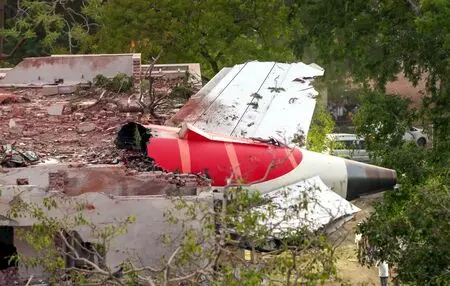Air India crash: Preliminary report flags fuel cut-off seconds after take-off
As engines fail mid-air, cockpit voice captures pilot’s stunned question: ‘Why did you cut off?’

A file image from the Air India crash in Ahmedabad on April 22. (Photo: IANS)
New Delhi, July 12: Fuel control switches of the Air India plane were cut off and later turned on before it crashed in Ahmedabad on June 12, killing 260 people, according to the preliminary report by Aircraft Accident Investigation Bureau (AAIB).
The Bureau also noted that there is no recommended action for now for the operators of Boeing 787-8 operators.
Releasing its 15-page report, a month after the fatal plane accident that happened in around 30 seconds after lift-off, the AAIB, on Saturday, also said fuel samples taken from bowsers and tanks used to refuel the aircraft were tested at the DGCA (Directorate General of Civil Aviation) Lab and were found satisfactory.
"Very limited amount of fuel samples could be retrieved from the APU filter and Refuel/Jettison valve of left wing. The testing of these samples will be done at a suitable facility capable of carrying out the test with the limited available quantity," it said.
The aircraft took off at 08:08:39 UTC (13:38:39 IST) and at about 08:09:05 UTC (13:39:05 IST) one of the pilots transmitted “Mayday, mayday, mayday”.
"The ATCO (Air Traffic Controller) enquired about the call sign. ATCO did not get any response but observed the aircraft crashing outside the airport boundary and activated the emergency response," the report said.
Citing the plane's Enhanced Airborne Flight Recorder (EAFR), AAIB noted that immediately after the aircraft achieved the maximum recorded airspeed, "engine 1 and engine 2 fuel cut-off switches transitioned from RUN to CUTOFF position one after another with a time gap of 01 sec".
As per the report, the engine N1 and N2 began to decrease from their take-off values as the fuel supply to the engines was cut off.
"In the cockpit voice recording, one of the pilots is heard asking the other why did he cut-off. The other pilot responded that he did not do so," it said.
The preliminary report was widely anticipated to throw more light on what could have led to the crash, which was one of the worst in India in decades, and also it was the first accident involving a Boeing 787 aircraft that resulted in hull loss.
AAIB said the wreckage site activities, including drone photography/ videography have been completed and the wreckage has been moved to a secure area near the airport.
"Both engines were retrieved from the wreckage site and quarantined at a hangar in the airport. Components of interest for further examinations have been identified and quarantined," it said.
AAIB is gathering additional details based on initial leads and data downloaded from the forward Enhanced Airborne Flight Recorder (EAFR) is being analysed.
The plane that crashed was powered by GEnx-1B engines.
Statements of the witnesses and the surviving passenger have been obtained by the investigators.
The complete analysis of postmortem reports of the crew and the passengers is being undertaken to corroborate aeromedical findings with the engineering appreciation, AAIB said.
The probe is continuing and the investigation team will review and examine additional evidence, records and information that is being sought from the stakeholders.
On June 12, Air India's Boeing 787-8 aircraft operating flight AI 171 en-route to London Gatwick crashed into a medical hostel complex soon after take-off from Ahmedabad, killing 260 people, including 241 persons who were onboard the plane.
One passenger survived the crash.
PTI
